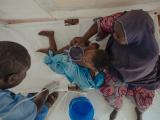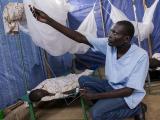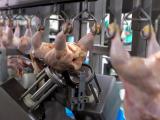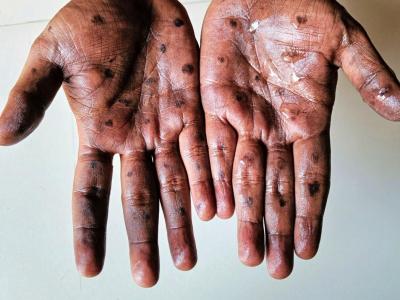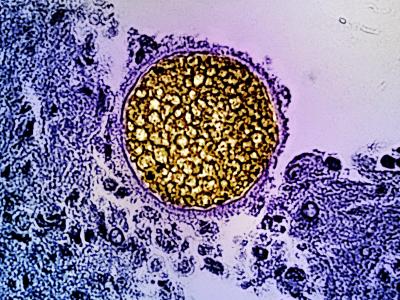Jun 27, 2008 (CIDRAP News) – Frustrated federal officials today reported they were still hunting for a major break in their investigation of a nationwide Salmonella outbreak thought to be caused by tomatoes, and for the first time they hinted that another type of produce might be responsible for the illnesses, which have now risen to 810 confirmed cases.
David Acheson, MD, associate commissioner for foods at the US Food and Drug Administration (FDA), at a press briefing today said teams of investigators have spent the past week taking hundreds of samples from farms, packing houses, and distributors in Florida and Mexico.
Of about 1,700 samples collected so far—mostly of tomatoes—none have yielded the relatively rare Salmonella enterica Saintpaul strain found in the sick patients, he said.
In early June the FDA warned consumers not to eat raw red plum, red Roma, or red round tomatoes, or products that contain any of those varieties, unless the growing areas are on a list posted on the agency's Web site. The agency is focusing its investigation on farms in southern Florida and certain Mexican states that were harvesting tomatoes when the outbreak began.
America's biggest produce outbreak?
Patricia Griffin, MD, chief of the Enteric Diseases Epidemiology Branch at the Centers for Disease Control and Prevention (CDC), told reporters that states are still completing and submitting laboratory results. She said the number of cases shown to match the outbreak strain has risen to 810, from 36 states and the District of Columbia. The latest illness onset is Jun 15, which is 2 days later than the CDC's last update.
Though the epidemiologic investigation shows that there is a strong connection between the sick patients and tomato consumption, Griffin said the CDC is keeping an open mind about the possibility of other contaminated produce items, especially since many of the case-patients reported eating salsa, guacamole, and other items that contained a mix of produce ingredients.
Griffin said the outbreak is considered to be ongoing, though a large portion of the illness onsets occurred in the last 2 weeks of May and in early June. She said it wasn't possible to provide an epidemiologic curve because data on the outbreak are still coming in.
As in other recent updates on the outbreak, the CDC said the new cases mainly reflect increased surveillance by state health departments and completion of lab tests, rather than a surge of new cases.
Based on information from 523 patients, at least 95 people were hospitalized, but no deaths have been blamed on the outbreak. (As mentioned in the CDC's earlier updates, however, salmonellosis may have contributed to the death of a Texas man who died of cancer.)
The outbreak may be the largest ever attributed to fresh produce in the United States. Craig Hedberg, PhD, a foodborne disease expert at the University of Minnesota in Minneapolis, told CIDRAP News he was unaware of a larger outbreak.
In 2006, an Escherichia coli O157:H7 outbreak linked to fresh spinach sickened 205 people. In 2004, three multistate Salmonella outbreaks involving tomatoes totaled 561 cases, according to previous reports.
Distribution complexities hamper trace-back
Acheson said an important lesson investigators have learned over the past week is how complex the tomato packing and distribution system is. Tracing backward from boxes delivered to stores or foodservice institutions is difficult, because packers often include tomatoes from different growing regions, both domestic and imported. "They're repackaged to meet specific customer requirements, such as small ripe tomatoes," he said. "This is a very common practice."
To further complicate matters, Acheson said investigators have found that in some instances, Florida tomatoes were repackaged in Mexico and Mexican tomatoes were repackaged in Florida.
"This makes tracing extremely difficult. It's important to control expectations—we may never find the smoking gun," he said.
Acheson said federal investigators consulted with tomato industry experts early on in the search for the source of the contamination. "We've learned a lot about growing systems and packaging. We've gotten a lot of cooperation," he said.
He expressed frustration with the trace-back problems, but said he wasn't' sure if laws regulating packaging would solve the problem. "We've got to improve the process. We're not getting an answer fast enough," he said.
Expert: Systemic flaws hobble outbreak investigation
Earlier this week, Michael T. Osterholm, PhD, MPH, an infectious disease expert who has led large outbreak investigations, including some involving tomatoes, criticized the federal government's handling of the Salmonella outbreak. In an interview published Jun 24 on PerishablePundit.com, a Web site and blog published by food industry expert Jim Prevor, Osterholm charged that the FDA and the Centers for Disease Control and Prevention (CDC) have bungled the effort to find the source of the contamination.
Osterholm, who is director of the University of Minnesota Center for Infectious Disease Research and Policy, publisher of CIDRAP News, further clarified today in an interview with CIDRAP News that his criticisms are mainly aimed at the entire foodborne illness surveillance and investigation system and not any one individual or agency. He said the current leadership structure at the agencies is inadequate for meeting the demands of a fragmented and disjointed surveillance and outbreak investigation system.
Public health authority rests with state and local departments, Osterholm said, and he acknowledged that federal officials often don't have the authority to assign outbreak response a higher priority. He said communication between state and local health departments and federal public health officials is often poor and that states vary widely in their ability to conduct and quickly report laboratory tests. "We have a very fragmented system with major delays. For time-sensitive outbreaks, you can't have that happen," he said.
"The overall system is broken," Osterholm said. "It looks like we're doing a lot, but I want to know how many cases we've prevented—a very small percentage, I would argue."
He questioned whether the FDA and CDC are making the best use of industry experts who are not directly involved in the outbreak. "In many instances, industry has the best intelligence. You bring together wise, experienced people who don't have a vested interest," he said, adding that current outbreak investigations are often hampered by inexperienced field personnel who depend too much on looking at farm, producer, and distributor records.
Osterholm also criticized the media for focusing too much on the large number of cases in the outbreak, which he said leads people to believe they are still at great risk for tomato-related illnesses. Reporters should press the CDC for more details about the peak of the illnesses, which would provide a more realistic assessment of the current risk, he argued.
"The media is so poorly trained on these issues. They need to ask more meaningful questions to put the outbreak in context," he said.
An incomplete case-control picture
Case-control investigations are a very powerful tool during outbreak probes, but the FDA appears to have made a major mistake by tracing back only the tomatoes eaten by the sick patients ate and not those consumed by the healthy controls, Osterholm asserted. He said tracing the control-group tomatoes would help investigators zero in on tomatoes from some sources and eliminate others. In this instance, tracing the control tomatoes would also help authorities zero in on whether tomatoes really are the source of the outbreak, he said.
At a Jun 20 news briefing on the outbreak, a reporter asked Acheson if investigators had tried to trace tomatoes consumed by the healthy controls. "We've not done that, we don’t routinely do that," he said. "It's an intriguing possibility, but no, we don't do that."
In the first investigations of multi-state tomato-related Salmonella outbreaks, back in the 1990s, tracing the tomatoes consumed by both case-patients and healthy controls was a key step in finding the source of the problem, according to Osterholm and Hedberg, who worked together on the investigations.
"If you don't trace control tomato sources, you have no perspective on the many possible sources that show up for cases," Hedberg told CIDRAP News recently. He and Osterholm both said that unless the FDA takes this step, it may never find the source of the outbreak.
Murky rationale behind cleared growing areas
Osterholm also charged that the FDA has failed to explain clearly how it has determined which states and countries are not associated with the outbreak. Since early in the episode, the agency has posted an online list of states whose tomatoes were judged to be safe. Consumers have been advised not to eat raw red plum, red Roma, or red round tomatoes unless they come from one of the listed growing areas.
"Right from the get-go, it was unclear how FDA was coming up with that list," Osterholm told the Perishable Pundit. "If any place not producing in late April/early May is safe, why the confusion and piecemeal additions to the list day by day? . . . If FDA believed states and countries not in production at the time of the outbreak were safe, they should have included all states and countries in that category."
On the other hand, he said, the FDA has suggested that tomatoes might be getting contaminated by a re-packer somewhere along the distribution chain. If that's the case, the list of safe areas would be invalid, he charged. In any case, it's unclear whether the list is based on dates of production or some other criterion.
Osterholm's conclusion was that the list "was based on those [growing areas] that screamed the loudest, and from a public health standpoint that's not right."
The FDA and CDC this week declined invitations from CIDRAP News to respond directly to Osterholm's critique, saying their experts were too busy dealing with the outbreak.
See also:
Jun 27 CDC Salmonella outbreak update
Sep 6, 2007, CIDRAP News story "CDC warns of Salmonella risk from tomatoes"
Dec 1, 2005, CIDRAP News story "Produce linked to more disease cases than poultry"

